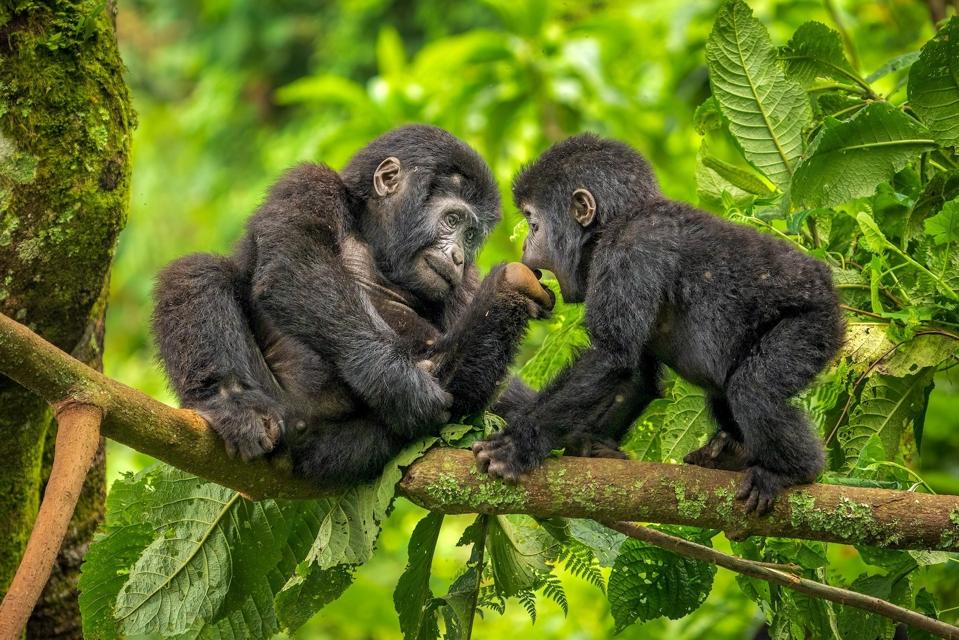Each year, the Nature’s Best Photography Awards gives us a glimpse into the raw, breathtaking beauty of wildlife. But sometimes, it also reminds us that nature isn’t always as serious as it looks; animals can be just as funny, awkward and endearing as we are.
This year’s Animal Antics category delivered moments of pure joy: gorillas in a tickle fight, lemurs posing like a dance troupe, and monkeys caught in an unfiltered display of affection. As a biologist, these moments make me laugh. This isn’t just due to how cute they are, but also because they reveal something deeply human about primates, our closest relatives.
Here are three of my favorite winning photos from 2025’s contest that capture the lighter side of primates’ life in the wild.
1. Mountain Gorillas (Bwindi Impenetrable National Park, Uganda)
In this shot, a pair of young mountain gorillas (Gorilla beringei beringei) sit perched upon a tree branch, looking more like a pair of kids at recess than a pair of primates. Here, Bwindi Impenetrable National Park — a UNESCO World Heritage Site and one of the last refuges for this endangered species — provides these gorillas the perfect playground.
“These playful youngsters were comical to observe when we trekked through this critical gorilla forest habitat,” writes photographer David Swindler on his experience with these siblings.
From a biological standpoint, the play behavior we see in this picture is actually essential to these gorillas’ survival. Among primates, roughhousing is a way of practicing for social skills, dominance hierarchies and emotional regulation — just like it is for human children. As a study from Genome Research notes, mountain gorillas share 98% of our DNA; in this sense, it isn’t all that surprising how similar our behaviors are.
Nevertheless, you can’t help but smile when looking at this pair. They remind us that even in the heart of one of the world’s most biodiverse forests, laughter is a universal language.
2. Ring-Tailed Lemurs (Madagascar)
There’s something unmistakably precious about this image of a ring-tailed lemur (Lemur catta) gnawing on his own tail. However, this is far from the most interesting tail-related behavior naturalists have observed in this species.
As 2017 research from the American Journal of Primatology explains, ring-tailed lemurs are also known for “stink flirting.” Absurdly, this involves a male lemur anointing his tail with secretions from his scent glands, and then wafting it at a female in the hopes of impressing her. But just as it would be for any human female, this behavior often results in some aggression toward the male.
3. Brotherly Hug: Proboscis Monkeys (Borneo)
This photograph of two proboscis monkeys (Nasalis larvatus) locked in what looks like a tight embrace is as heartwarming as it is hilarious. But as funny as their wide, fleshy noses are, they actually serve an important evolutionary role.
As 2025 research from the Journal of the Royal Society Interface notes, a male’s oversized nose actually acts like a built-in billboard and bass amplifier. Specifically, it signals his physical and sexual maturity to potential mates and rivals.
The bigger the nose, the deeper the call, thanks to the nasal acoustics that exaggerate their body size. So, as funny as their noses might look to us, they’re actually almost brag-worthy among proboscis monkeys. And in their complex social world, those nasal notes help everyone keep tabs on who’s who.
Yet, for the same reason why I imagine Fernández titled this shot “Brotherly Hug,” it’s hard not to anthropomorphize the photo. To us, it still looks like two friends who are caught mid-laugh, holding each other steady in what must be for them a chaotic world.
A Wild Reminder
The 2025 Nature’s Best Photography Awards has given us stunning landscapes and daring adventures. But beyond this, each year, it also gave us a reason to smile. Underneath every predator-prey chase or sweeping Arctic vista, there’s always a simpler truth: that animals are curious, emotional and often unintentionally funny. They remind us that wonder and humor can indeed coexist, and that the wild world is, in its own way, full of joy.
Are you an animal lover who owns a pet? Take the science-backed Pet Personality Test to know how well you know your little friend.





